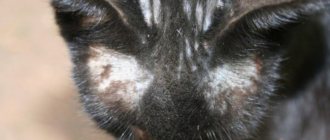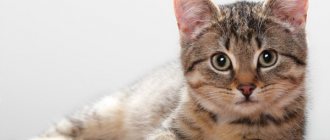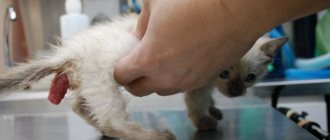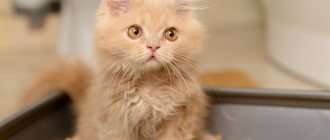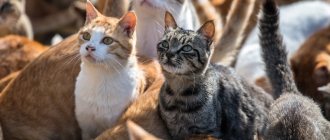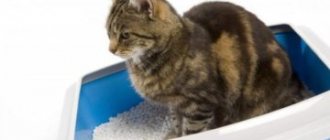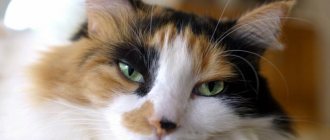What is ringworm in cats and what does it look like?
This disease is the collective name for fungal infections that mainly affect the pet’s skin and, less commonly, the claws. Moreover, it does not matter whether the animal goes outside or is completely domestic. The disease is transmitted by trichophyte and dermatophyte fungi, which is why lichen is also called microsporia, trichophytosis or dermatophytosis.
Lichen spores can only be examined under a microscope; they can be transmitted through the air and settle on clothing and any surfaces. Therefore, close contact with the carrier of the disease is not necessary - an animal can get sick if it rubs against its owner’s clothes or lies on the grass where a sick cat was previously sitting.
Tiny spores can remain for a long time in the grass and on the ground, furniture, carpet or clothing. They retain good viability for almost 2 years, and when exposed to favorable conditions (warmth and high humidity), they begin to actively reproduce and cause disease.
In order to detect the disease in time at the initial stage, you need to know what the sick animal looks like. The main symptom of lichen is breaking off and loss of hair on the affected areas of the skin. Bald and flaky pink spots on the skin resemble those cut with a clipper, which is how the disease got its name.
The following animals are most often susceptible to deprivation:
- small kittens;
- young individuals up to 1 year of age;
- adults whose immunity is weakened due to an inadequate diet and lack of nutrients;
- long-haired breeds;
- cats with malignant processes in the body.
Signs and symptoms
The incubation period of the disease is almost 3 months, so symptoms may not appear immediately. At the initial stage, it is almost impossible to recognize the first signs and determine lichen in a cat, but already at this stage the pet becomes infectious to the people and animals around it.
The main symptoms of ringworm in cats:
- deterioration in the condition of the coat is expressed in its breaking off, dullness and greasy;
- in some places bald spots appear, on which broken hairs are visible, gradually this area becomes more bare;
- bald areas become pink (less often gray-brown) and begin to become covered with scales and crusts;
- the animal loses its appetite, becomes lethargic and apathetic;
- due to constant itching, the cat begins to actively itch and bleeding scratches appear;
- when the claws are damaged, they become deformed;
- Over time, blisters may appear on the surface of the epidermis, which become covered with crusts, and if a secondary infection occurs, ulcers may appear.
The degree of damage to the skin and fur manifests itself depending on the state of health and immunity of the animal: in a healthy cat, only 1-2 spots are possible, in a weakened cat, lichen covers large areas of the body. The most commonly affected areas are the head, neck, muzzle, ears, back, tail and paws in the claw area.
Signs of infection, diagnosis
To become infected with cat lichen, you do not have to come into contact with an infected animal. Fungi that cause the disease spread through microscopic spores through the air and can settle anywhere. Even a domestic cat is at risk of getting sick. For example, the owner can sit on a bench where an infected animal previously lay. When he returns home, the cat only needs to rub against his legs to catch the infection.
Of course, such cases do not happen often, and it is not worth living in constant tension. You just need to not ignore the first warning signs - scratching, bald spots, more abundant shedding than usual.
The incubation period from the day of infection until the appearance of the first symptoms is from one week to three months. Much depends on the animal’s immunity.
Ringworm occurs in two forms:
- Microsporia. The skin of the nose, ears, head, paws, and less commonly other parts of the body are affected. If the lichen is located on the paws, then the claws become deformed. The fur breaks off at skin level, individual hairs are easily pulled out or fall out. This contributes to the spread of the disease - fungal spores attached to the base of the hair immediately spread through the air.
- Trichophytosis is much less common. In this form, only the cat's head and neck become bald.
Signs of ringworm in cats are the same for both forms of the disease:
- Small bald patches appear. They are almost invisible; it may seem that a small piece of fur was lost when the cat got caught on something or had a fight with other cats. At this stage, the cat behaves calmly and has a normal appetite.
- Bald patches are increasing. They do not have clear outlines; individual spots, spreading across the skin, unite into one large spot of uncertain shape. This spot also continues to spread, affecting larger and larger areas. Baldness is noticeable; whitish scales appear on the areas affected by lichen; they look like an ash-white coating.
- The animal is covered with extensive spots, the hair next to the spots is broken off and looks “mowed”. Bald areas may be greyish, yellowish or reddish in color. The cat becomes restless and suffers from itching.
In more advanced cases, the cat’s well-being worsens. Appetite disappears, depressed mood and anxiety appear.
Only a veterinarian will be able to make the correct diagnosis and prescribe the treatment necessary in a particular case. A number of laboratory tests are carried out to confirm or refute the diagnosis:
- Wood's ultraviolet lamp. The area affected by the skin disease is illuminated with the rays of a lamp. In the light of this device, the fungi begin to glow green. Usually this test is sufficient, despite the fact that the error of the method is 40%, because the doctor also focuses on the clinical picture and his experience. If the owners have already used certain medications or iodine or brilliant green for treatment, the doctor should know about this, since they suppress the glow. Completely different microorganisms can also glow. If something confuses the doctor, then other tests are prescribed.
- Scraping of skin and hairs. The biomaterial is examined under a microscope and gives highly accurate results.
- Sowing. The scales collected by scraping from the affected area are placed in a dermatophyte-nutrient medium. The nutrient medium provokes the growth of only the desired type of fungus. This test is the most accurate and provides the maximum information. But it is used only when absolutely necessary, since results can be expected within 1.5–3 weeks.
Microsporia is difficult to treat, especially in advanced cases. It is important to consult a doctor at the slightest suspicion of illness.
Treatment for ringworm at home
A consultation with a veterinarian will help you find out how and how to treat ringworm in cats. After confirming the diagnosis in the laboratory and prescribing drug therapy by the doctor, the owner of the sick animal is recommended to take the following actions:
- try to isolate the sick pet from people and pets or minimize their contacts, prevent their presence on beds, sofas, etc.;
- be sure to examine all pets for signs of deprivation and take preventive measures;
- Until recovery, the cat cannot be bathed, because this will cause the spread of fungal spores throughout the body, with the exception of special medicated shampoos;
- treat the animal with gloves and do not stop treatment until complete recovery;
- improve the diet and living conditions of a sick pet to improve immunity.
Folk remedies also have a positive effect:
- An ointment based on wood ash and pork fat or butter (mixed in equal proportions). Used to treat the source of infection. A bandage is placed on top, which helps enhance the effect and prevent the cat from licking the medicine.
- Bathing in a solution of lime sulphide (1 tsp per 5-6 liters of warm water). The cat must be completely immersed in a container with the solution, and the diseased areas must then be moistened additionally. After the procedure, the fur should be blotted with a cotton towel or paper napkins and dried; do not allow the pet to lick itself. The method is not suitable for kittens, because... Possible side effects such as allergies, skin irritation or vomiting.
- Treatment of diseased areas with a solution of laundry soap (you will need 10-15 g of shavings per 1 liter of water). Wet a cotton pad and use it to remove dried crusts.
- Lubricating foci of infection with iodine or propolis 1-2 times a day. This method is contraindicated for pets with particularly delicate skin, because... burns may occur.
It is recommended to give a pregnant cat a decoction made from medicinal herbs (chain, nettle, violet, 0.5 tsp per 0.5 liter of boiling water). It is infused for 20 minutes, filtered and given to the animal 3-4 times a day.
The disadvantage of traditional methods of treatment at home is their low effectiveness, as a result of which the disease can become chronic. Therefore, for a faster positive result and complete cure, experts recommend using medications.
Ringworm in pets
What is ringworm
Dermatomycosis of the skin (ringworm) is a contagious infectious disease caused by pathogenic fungi.
The skin and its derivatives (fur, claws, whiskers) are affected.
Fungal diseases often accompany tick-borne infestations.
The disease does not have a seasonality, but most often outbreaks of the disease occur in cold weather.
The disease is dangerous for all breeds of dogs, cats, ferrets, rodents (rabbits, chinchillas, guinea pigs, degus, rats, mice, hamsters) and humans, especially for children, the sick and the elderly.
How does fungus spread?
The reservoir of infection is stray animals (in most cases cats), as well as small rodents (rats, mice).
Ways of infection of pets:
- contact with a sick individual (including children infected with the fungus)
- introduction of parasite spores on the owner’s shoes and clothes
- contaminated litter, equipment
A predisposition to pathology occurs in weakened animals, in pets with immunodeficiency, as well as in those living in a warm, humid climate.
The outbreak and spread of the disease is facilitated by:
- poor living conditions
- poor feeding, vitamin deficiencies
- acute and chronic diseases
- stress
What happens when infected
The pathogen enters the mammal's body through the skin, especially if there are scratches, abrasions, or cracks on it. The spores/mycelium of the parasite go through all stages of development, growing into the hair follicles and epidermis.
During this process, the fungus releases waste products that cause inflammatory reactions. In this case, the skin becomes rough and thick, the mouths of the follicles expand, and purulent exudate accumulates in them.
The hairs break as they emerge, and many scales and crusts containing the mycelium of the pathogen form on the surface of the body. They fall off easily and serve as a source of infection.
The penetration of pathogenic fungi into the deep layers of the skin leads to the development of purulent inflammation and severe complications.
Types of ringworm in pets
After 7-30 days from the moment of infection, the first symptoms of fungal infection appear. The causative agents of the disease are localized at the hair roots, making them fragile and brittle.
All types of ringworm are characterized by the presence of lesions and hair loss. The general condition of the pet depends on the area of the lesion and the type of pathogen that caused the disease.
In this case, the itching that accompanies the disease leads to anxiety in the pet, loss of sleep and appetite.
The fungus also affects other mammals, especially during the molting period, when wool containing parasite spores is easily transported throughout the apartment, settling on upholstered furniture, textiles, and household items.
Microsporia
A zooanthroponotic disease caused by pathogenic Microsporum fungi that parasitize animals and humans. Cats and dogs are prone to this type of lesion.
Infection occurs from infested animals and spreads through contact or through infected objects.
The disease begins in the head, limbs and neck. 1-2 slightly hyperemic lesions of rounded outlines with clear boundaries appear on the pet’s body. The skin on them peels off, the hair is broken off at approximately the same level (3-8 mm from the surface) and is easily pulled out.
On a smooth surface they are presented as round or oval ring-shaped formations with a peripheral ridge consisting of vesicles, papules and crusts. The inside of the skin is covered with dead epidermis, then gray crusts appear.
In the cortical form, dense elevations that are sensitive to pressure appear on the skin. They are dark in color and practically devoid of fur.
Trichophytosis
A fungal disease of dogs, cats, ferrets and small rodents, in which pathogenic microorganisms (Trichophyton fungus) affect the skin, fur, whiskers, and claws.
Superficial invasion occurs more often in young animals and is characterized by the appearance of numerous small pink lesions with unclear boundaries. The skin on the affected area peels slightly, and the hairs inside it break off at the level of the dermis or 2-3 mm from it.
Deep (infiltrative-suppurative) trichophytosis is caused by zoophilic fungi. A rounded inflammatory infiltrate forms on the body, the surface of which has multiple pustules riddled with hair.
After some time, the hair in these places falls out, and pus is released from the follicle, which shrinks into crusts. As a result of deep degenerative processes, bald spots devoid of pigment remain on the body.
When the skin is damaged by fungi of the genus Microsporon, ringworm in animals proceeds more benignly in comparison with the pathogen of the genus Trichophyton.
Sick dogs, cats, ferrets and rodents almost always have affected nails, which also require antifungal treatment.
Scab (favus)
The disease is sporadic. The lesions are located at the base of the claws and on the head. Sometimes the lesion can be found on the abdomen, chest, inner thighs, and around the anus.
Round spots form on the skin, densely covered with a thick layer of gray-green crusts, which gradually rise at the edges, taking on the appearance of a saucer or shield.
If treatment is not started in time, they merge into continuous layers, from which a characteristic putrefactive odor emanates.
After illness, animals develop unstable immunity.
Diagnosis of lichen
The clinical diagnosis is confirmed by the presence of a greenish glow of the affected fur in the rays of a Wood's lamp and the manifestation of characteristic symptoms.
It is possible to definitively confirm ringworm and identify the type of pathogen by examining scrapings from the affected areas.
What to do if your pet has shingles
If you suspect that your pet is infected with a fungus, call a veterinary dermatologist ! It is strictly prohibited to bring a four-legged animal to the clinic; there is a possibility of the pathogen spreading and an epidemic outbreak.
At home, a specialist will examine all animals (if any) and prescribe treatment. ( A veterinarian comes to your home 24 hours a day )
Local therapy is reduced to treating the affected areas. If the process is extensive, it is not recommended to treat the entire body at once; the antifungal drug is toxic and can cause poisoning or skin burns.
First, the head area is treated, after 6-8 days the neck, back, and limbs.
Identified sick individuals should be isolated, and healthy ones should be prescribed a course of antifungal drugs.
All care items, utensils, and toys must be thoroughly disinfected.
Treatment of ringworm is long and persistent, since the fungus retains its pathogenic properties on any surface for a long time, and it is extremely difficult to destroy it.
To avoid the spread of infection, strict adherence to personal hygiene measures is necessary, since the disease is also dangerous for humans.
Treatment with drugs
Treatment of lichen is carried out comprehensively and systematically using the following anti-lichen drugs prescribed by a veterinarian:
- Vaccines for the treatment of ringworm (trichopytosis and microsporia) - Vakderm F, Polivac TM, which are administered intramuscularly in the area of the femoral muscle 1-2 times with an interval of 2 weeks. Used at the initial stage of the disease.
- Ointments with antimycotic action. Used for local treatment.
- Special shampoos with antifungal ingredients (Nizoral with ketoconazole, Doctor skin shampoo, Antiseptic & Antifungal vet shampoo). They are an addition to the main course of treatment, because help reduce itching, have a positive effect on the skin and speed up recovery. Before use, the area around the affected area must be shaved and treated with an antiseptic.
- Sprays for animals (Fungin, Vakderm, Mycostop Provet). Medicines containing clotrimazole, which are applied to the affected area, the course is 1-2 weeks.
When choosing medications for complex therapy, the veterinarian takes into account several factors:
- the size and number of affected areas on the pet’s skin;
- severity of the disease and general condition of the animal;
- state of immunity.
You should know that antifungal drugs should be used in quantities of no more than 2 types and forms, so that the active ingredients do not accumulate in the animal’s body, because this can lead to toxic poisoning.
Tablets for lichen
Antifungal medications taken orally, in tablet form:
- Griseofulvin (analogs Gricin, Fulcin, etc.). Intended for the treatment of humans, but can also be used for cats. The dosage depends on the weight of the pet - 40 mg/kg, given half or a whole tablet crushed into powder twice a day with food. The medicine has side effects (diarrhea, nausea, liver damage, lethargy) and contraindications.
- Itraconazole (or similar drugs Irunin, Orungal, etc.). Available in tablets and capsules, for cats the dosage is ¼ tablet twice a day (for kittens - 1/8 tablet or capsule, depending on the pet’s weight 10 mg/kg). Give with food for 7 days, then another 2 weeks - every other day in the same amount. The course of treatment is from 4 to 6 weeks. Possible side effects such as nausea and decreased appetite.
- Terbinafine (analogs Lamisil, Exifin). It is given to animals at the rate of 30 mg per kilogram of weight for 3-4 weeks, and is also used in kittens. Side effects include loss of appetite and allergic reactions due to individual intolerance.
In addition, there are drugs in the form of injections. One of them is Dermikotsid, which is an antifungal drug for the treatment of microsporia and trichophytosis. Injections are given into the thigh muscles 2-3 times with an interval of 5 days. For kittens, the dosage is 0.5 ml, for adult pets - 1-1.5 ml. The drug has side effects in the form of an individual reaction on the skin (urticaria, rash), the appearance of redness in the eyes and mucous membranes of the mouth.
Ointments
Before starting local skin treatment with gels or ointments, it is necessary to trim the hair around the diseased area and remove crusts, which will help improve contact of the medicine with the epidermis. To prevent the cat from licking the applied ointment, it is necessary to put a special collar or bandage on it.
To improve the condition of the epidermis and local antifungal action, the doctor prescribes an ointment for ringworm from the following list:
- Clotrimazole. The gel is applied to the affected areas three times a day for up to 30 days (if necessary, longer, until complete recovery).
- Sanoderm. A complex drug that includes a local antibiotic, an antimycotic drug and anti-inflammatory ingredients. Apply 1-2 times a day for 2-4 weeks (duration depends on the severity of the disease). Before using it, you should consult a veterinarian, i.e. the drug has contraindications.
- Miconazole. A remedy for the treatment of fungal diseases in people and animals, which need to be smeared twice a day on diseased areas, the course is 1-2 months.
- Fungin. An effective remedy in the treatment of trichophytosis and microsporia. Apply in a dosage of 0.2-0.3 ml per 1 kg of pet’s weight using a cotton pad and gently rubbing into the skin. Treatment should be carried out daily for 12-15 days.
- Sulfuric ointment. It is a simple, cheap and most harmless way to cure skin diseases, but is effective only for minor lesions. Apply 3-4 times a day to diseased areas of the skin.
- Ointment "Yam". It has acaricidal, fugicidal and keratolytic effects, applied in a thin layer to the skin and around the affected area (3-4 cm more) 1-2 times a day, the course of treatment is 8-10 days.
In chronic forms of lichen and severe bleeding scratches, a secondary microbial infection may occur and symptoms of purulent dermatitis may appear. In such a situation, the doctor prescribes antibiotics in the form of injections or tablets.
Treatment for ringworm takes at least 1-1.5 months. Evidence of a cat’s recovery is not the disappearance of external signs of the disease, but a negative result after testing scrapings taken from the animal’s skin (sometimes the testing procedure is carried out twice).
Diagnosis of the disease
Inoculation of the pathogen depriving on a nutrient medium
The effectiveness of treatment depends primarily on the correct diagnosis of the form of the disease. If the owner suspects that the cat has lichen, what to do in this case: it should be shown to a veterinarian as soon as possible.
After a clinical examination, the pet’s skin is illuminated with a special Wood’s lamp. When exposed to light, fungal colonies fluoresce (glow bright green). This method is not always informative, since some non-pathogenic fungal spores also react by glowing to ultraviolet light.
Correct diagnosis in an outpatient setting will allow you to select the most effective medications, since removing lichen from a cat is not an easy task. Therefore, modern veterinary medicine approaches the issue of diagnostics comprehensively.
More reliable ways to determine the disease are microscopic examination and inoculation of the pathogen on a nutrient medium, followed by its identification. Lichen is differentiated from dermatitis, allergies, and pyoderma.
Is ringworm transmitted to humans?
The main danger of the disease is that lichen is contagious to humans. In this case, people can be affected in any part of the body (arms, legs, etc.), often the skin under the hair on the head. Pink spots appear with clear edges. They may be slightly raised above the skin. Hair on the spots always falls out and grows back only after the end of the course of therapy and cure.
Most often, children of preschool age, who have not yet developed immunity, and adults who have a weak immune system are infected with lichen. In people with a strong, healthy body and high immunity, fungal spores can live on the skin for quite a long time and remain in a suppressed state.
Similar diseases
Ringworm is often confused with other diseases. Especially with weeping, pink and multi-colored lichen. It wouldn’t hurt to look at what lichen in cats looks like in the photo and read the description of the disease.
Weeping eczema
Ringworm is not actually ringworm. That is, it is not provoked by any fungal organisms, it is not transmitted to humans.
The cause of the disease may be:
- problems with immunity;
- fleas, ticks, helminths that attacked the cat;
- allergies to food, to hair care substances;
- failure in the hormonal system;
- severe nervous shock.
Weeping eczema begins with red spots appearing on the cat's body, noticeably hotter than healthy skin. The spots become covered with blisters containing mucous fluid. When they burst, eczema becomes noticeable even on long hair. The affected area hurts so much that the cat does not allow the sore to be touched. For treatment, sulfur, salicylic, tar ointments, and a vitamin complex are prescribed.
Gibert's disease
Ringworm rosea (another name is Zhiber's lichen) is especially often mistaken for ringworm.
The main external difference is that pityriasis rosea consists of separate pink spots that do not merge with each other, which eventually become covered with a dry crust. They are clearly defined, round or oval in shape.
The ringworm does not have clear outlines, and the affected areas merge with each other.
For humans, pityriasis rosea is not contagious. The cause of lichen is low immunity in cats. Immunostimulating drugs are prescribed. It is also necessary to use ointments that will restore damaged skin.
Multicolored disease
The infectious fungus Pityrosporum is the cause of pityriasis versicolor (pityriasis versicolor). This fungus is present on the skin of both animals and humans. When favorable circumstances occur (decreased immunity), it awakens. Tinea versicolor is of fungal origin and is contagious to humans. A person with poor health can get sick quickly; in people with strong immunity, the disease may not manifest itself for years.
Characteristic symptoms for lichen:
- the appearance of oval elongated lesions on the body, the spots can be either single or merging;
- color varies from pinkish yellow to brown;
- severe inflammation is observed, as well as baldness of areas with lichen.
The treatment is long-term. The drug Imaverol is usually prescribed, the solution of which is used to treat the areas affected by lichen.
Feline dermatophytosis
Ringworm (feline ringworm, dermatophytosis) is a fungal disease. Known as microsporia and trichophytosis, because the parasitic fungal pathogens belong to the genus Microsporum canis, Microsporum gypseum and the genus Trichophyton. Microorganisms that get on the skin take root in its upper layers and feed on the epithelium.
Fungal spores may not manifest themselves for months; the impetus for their development will be:
- Decreased immunity. Cats have an innate immunity against microsporia; sometimes they can be carriers, but they themselves never get sick. But if the cat receives inadequate nutrition, is infected with parasites or falls ill, then there is a high probability of developing feline lichen.
- Cat breed. Artificially bred breeds do not have immunity to lichen (for example, Scottish, Persian cats).
- Warm and humid climate. This may be due to either a move or a damp room for some reason.
- The age of the cat matters - kittens, due to their underdeveloped immune system, are more susceptible to the disease than adult cats.
The disease is contagious to both other animals and people. Children are especially vulnerable. Dermatophyte fungi reproduce by spores that remain viable for two years. You can become infected not only from a sick animal, but also from household items if they contain spores.
Can other animals become infected?
This easily transmitted disease is spread by fungal spores that can affect any mammals, which include dogs, cats, and rodents. Animals that live outdoors are at greatest risk.
When one infected pet appears, everyone around them is at risk of getting sick. The infection may quickly spread among residents of shelters or cat and dog kennels. Therefore, it is so important for the owner to isolate the sick animal from people and other pets.
How to prevent a person from contracting diarrhea from a cat
For those who want to protect themselves, we can advise one thing - do not pick up unfamiliar cats and kittens, and do not let your pet out into the street. If a cat has not been vaccinated against ringworm, it is better not to give it to strangers and not to allow it into the habitats of other cats. It would be best to sign your pet up for a shingles vaccination. It is safe and will save you from many problems. The only thing that is required is to undergo an examination before the injection, since the vaccination can provoke an allergy in the animal.
Types of lichen in humans
Routes of transmission of ringworm
Spores of the fungus that causes the disease can spread quickly through the air, in the aquatic environment and through clothing.
Main routes of transmission:
- in direct contact with a sick animal (if protective equipment is not used);
- with indirect contact, infection can occur through pet care items - a bed, food bowls, harness or leash;
- through other carriers of infection - rodents (mice and rats);
- in the environment, spores can spread with water or through the air, through soil, sand, garbage, upon contact with which the fungus begins to develop;
- through items of clothing or shoes of the owner or other people coming into the house.
Prevention of lichen in cats
The main measures to prevent infection of pets with lichen include:
- good care and maintenance of the pet’s health and immunity;
- maintaining cleanliness in the room where animals live: regularly sanitize the bedding, house, feeder and drinking bowl, care accessories;
- when walking on the street, avoid contact with homeless and stray cats and dogs;
- carrying out preventive vaccinations that help protect the animal from ringworm and other types of lichen (these include Polivak TM, Vakderm, Microderm, etc.); with regular use of vaccines, the animal develops immunity to skin diseases;
- if your pet is suspected of being infected with lichen, it is necessary to provide personal means of protection against infection - wear a gown and rubber gloves when carrying out medical and other procedures for caring for a sick animal;
- After isolating a sick cat in a separate room, it is recommended to subject it to quartz treatment daily using a special lamp, and to carry out wet cleaning with a chlorinated solution (chlorhexidine or alcohol can be used).
The measures listed will help protect animals from infection, even in a situation where there is an animal with shingles in the house. If you follow all the doctor’s recommendations and the proper quality of treatment and maintain the health of your pet, lichen can be cured and complications and the transition of the disease to the chronic stage can be avoided.
Prevention
Prevention is the key to health!
The best way to prevent lichen in cats is vaccination. It is also supported by the fact that many varieties of fungus are resistant to antimicrobial drugs, and the veterinarian is not always able to choose the right effective remedy. Timely vaccinations can protect your pet from disease for a long time.
To prevent lichen, the Polivac vaccines are used. The drug is administered twice with an interval of 10-14 days. Immunity appears 20-30 days after repeated administration and lasts about a year.
In addition to vaccinations, there are a number of common preventive recommendations to prevent lichen infection:
- minimizing the cat’s contact with suspicious animals;
- mandatory treatment of wounds, scratches and any other damage to the animal’s skin with an antiseptic;
- regular veterinary examinations;
- maintaining hygiene, cleaning the premises, washing cat supplies;
- timely prevention against parasites;
- a complete diet.
